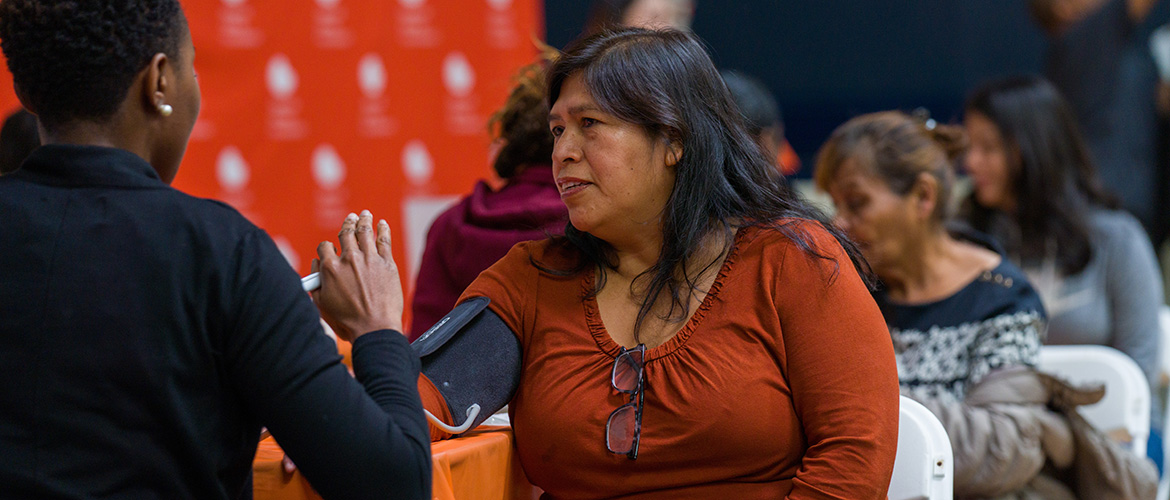Like millions of Texans, Maria Ocon relies on free screenings to try to stay healthy.
Ocon, 54, lives in the Dallas area and cleans houses for work. She is uninsured and isn’t eligible for Medicaid, and she struggles to manage her high blood pressure.
She was among more than 1,900 people who recently attended a community event where she enrolled in health coverage and received screenings, including for diabetes and high cholesterol. She was relieved her test results were normal.
“I haven’t had a medical checkup in a year,” Ocon said through a Spanish interpreter as she sat in a loud and bustling community center gym. “These events offer health screenings to people who wouldn’t otherwise get checkups because they’re so expensive. These health fairs are a good thing, and I’m very happy to have been screened and to know I’m healthy.”
Before joining the lengthy line for health screenings, Ocon first enrolled in the most affordable insurance coverage she could find — a high-deductible plan with no monthly premium to pay. Her coverage, which takes effect Jan. 1, includes preventive health screenings and exams at no cost to her even before she reaches the deductible.
“I’m really happy to be insured,” Ocon said. “I selected the plan because I don’t make enough money to pay monthly premiums,” she said. “Right now, what’s important is that the plan I chose allows me to get medical checkups.”
Meeting community needs
In 2019, more than 1 million Texans enrolled in health coverage through the Affordable Care Act. Yet, an estimated 5 million residents — about 17.7% of the state’s total population — still lack health insurance. Texas’ uninsured rate is almost twice the national rate.
However, about 60% of the state’s uninsured residents could enroll in Medicaid or get premium subsidies, said Dr. Bharath Thankavel, a Blue Cross and Blue Shield of Texas medical director who attended the Dallas enrollment and health fair.
The event was part of a community-based education campaign called Be Covered, which helps the uninsured and underinsured understand insurance benefits and identify their coverage option during the 2020 open enrollment period. Individuals have until Dec. 15 to enroll in coverage that begins Jan. 1.
Getting and using insurance coverage now will yield long-term benefits for many people, Thankavel says.
“It’s really about what’s going to be the impact on that person’s life five years from now, 10 years from now, 20 years from now, when they’re much more healthy,” he says.
Working families remain uninsured
Like Ocon, most people who are uninsured are U.S. citizens in working or low-income families living in Southern or Western states, according to the Kaiser Family Foundation. In 2017, more than 75% had at least one full-time worker in their family.
People living in states that have not expanded Medicaid to offer more residents health care coverage are most likely to be uninsured.
A separate 2018 Kaiser Family Foundation report focused on Texas revealed half of uninsured Texans surveyed said they could not afford health coverage or believed it was too expensive. Other reasons cited for lacking coverage included citizenship or residency requirements and the belief that health insurance was unnecessary.
Planning for 'what if’
Karen Travit, a senior advocate for Blue Cross and Blue Shield of Texas, helps uninsured Texans understand how insurance works and find affordable plans that meet their needs. She also describes the peace of mind coverage brings to her own life.
“When someone says they’ve never had insurance before, and I’ve had insurance all my life, I need to help that person get that security of insurance,” says Travit. “Putting their mind at ease makes me feel good.”
Some people know exactly what kind of plan they want. Others need more help in selecting coverage. All marketplace plans have no out-of-pocket costs for health screenings and other preventive care that people like Ocon seek.
“What we do is explain what you get with your insurance,” Travit says, such as annual exams and mammograms. “We kind of walk them through ‘what if.’ If you have insurance and you go for a wellness exam, if something’s wrong, they can start working on that. With insurance, it covers if there is a ‘what if.’”

